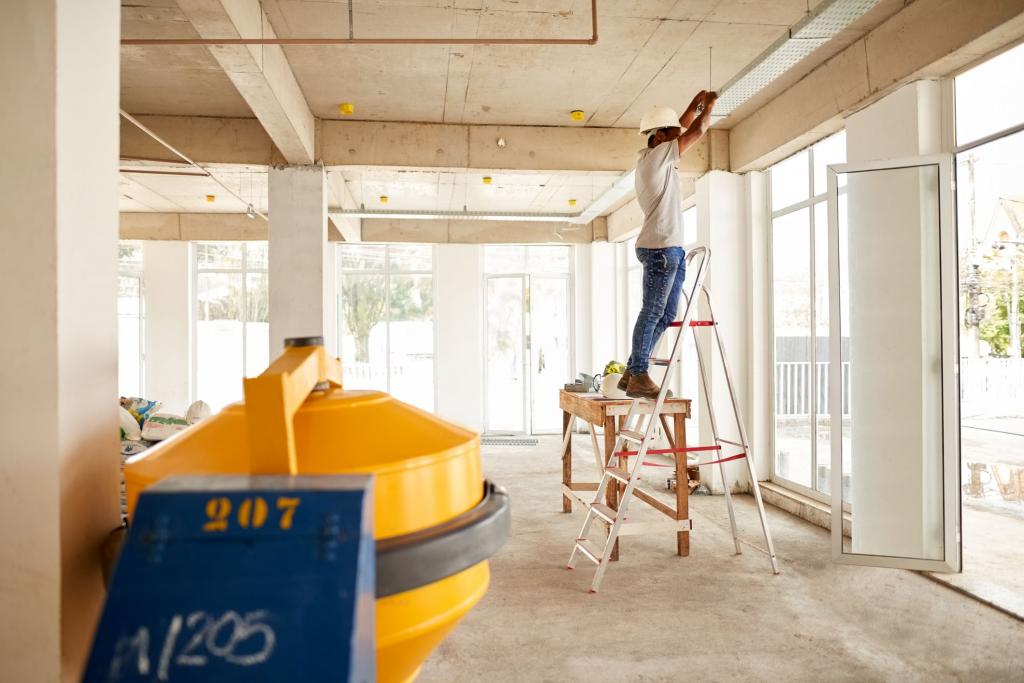The Revolution Will Be Retrofitted: The future of energy efficiency in Canada
When the Task Force for a Resilient Recovery submitted its final report with 5 “bold moves” the Canadian government should make to ensure a sustainable, prosperous path forward after COVID-19, investments in energy-efficient buildings topped the list. We sit down with Brendan Haley, Policy Director at Efficiency Canada, to talk about what these actually include, beyond thicker windows and new light bulbs.
Maybe we should start by talking about energy efficiency in general—what does this refer to? And where do retrofits come into the picture?
Energy efficiency is about using less energy to achieve the same or better energy services. We want the services of warmth, light, mobility, and productivity. It doesn’t make sense to pay the economic and environmental costs of energy waste. Efforts to reduce this waste can include energy upgrades in both residential and commercial buildings. It can also include more efficient transportation, such as electric vehicles, as well as more efficient industrial production or larger demand-side solutions, like shifting the timing of energy use, so it matches renewable energy availability.
But energy efficiency isn’t just about using less; it also means having better and more equal access to basic needs. For example, with rising temperatures, a lot of people will require access to cooler indoor environments. Keeping our buildings cool through better insulation, shading, and efficient equipment is a way to create a safer and fairer world while driving down greenhouse gas emissions.
When we talk about retrofits, are we talking about swapping light bulbs in our homes? Or something much bigger? Tell us what a typical retrofitting project in Canada might look like.
To reach our climate goals, we need to move toward deeper energy savings per building than we are currently seeing. Residential efficiency programs are achieving savings of about 10–20% today through things like air sealing, fixture replacements, lighting upgrades, and smart thermostats. But we really need to start seeing savings in the order of 30–50%, which might include more extensive building envelope upgrades and heat pumps.
Energy efficiency isn’t just about using less; it also means having better and more equal access to basic needs.
You mention swapping lightbulbs. I should note that there are still lots of lighting efficiency opportunities, especially if you incorporate things like smart controls. We keep finding new ways to save energy, and I expect this to continue. For example, advances in psychology and behavioural economics are complementing many of the traditional "hard" measures—such as installing new heating systems—with ways to motivate energy-saving behaviours through things like feedback, competition, and community goal setting.

How is Canada doing when it comes to energy efficiency?
Well, the American Council for an Energy Efficient Economy has an international policy scorecard. The last one was in 2018 when Canada tied with the United States for 10th place; Italy and Germany came in first.
On November 17, Efficiency Canada released its second scorecard of provincial energy efficiency policies. British Columbia was the top province because of policies such as the Energy Step Code that provides a regulatory pathway toward net-zero, energy-ready buildings, as well as a zero-emission vehicle mandate. Prince Edward Island was the most-improved province, leading in energy-efficiency programs overall—in particular, program spending for low-income and Indigenous People.
Yet, even the provinces that are saving the most are behind some of the leading American states like Massachusetts, California, and Vermont. For example, Nova Scotia had electricity savings equal to 1.2% of annual savings in 2019. That’s our top province, yet in the year prior, Massachusetts saved 2.8% of electricity sales. A North American comparison shows that the Canadian provinces have significant room to catch up.
We need to triple our efforts, and the comparisons we have done suggests this should be achievable.
And we need to catch up. In 2020, the Canadian government joined with other governments in a commitment to achieve 3% global annual improvements in energy intensity. This is the level the International Energy Agency says is needed to meet the Paris climate commitments. Canada has historically improved its energy intensity by 1% per year. So we need to triple our efforts, and the comparisons we have done suggests this should be achievable.
How has the energy-efficiency sector been impacted by COVID-19?
The lockdowns have slowed work because they limit activities such as home visits by auditors. At Efficiency Canada, we reacted to this by creating a database of training opportunities that can be accessed online to help people upgrade their skills and even find new career pathways. We’re also seeing new program innovations, such as the use of virtual energy assessments or targeting empty commercial buildings for upgrades.

The pandemic seems to be increasing demand for renovations. Many of us are now working from home on a full-time basis and have become more aware of buildings that are too hot in the summer and too cold in the winter. There is also increased concern about issues such as proper ventilation and air quality in our public buildings, for example, schools. These concerns present a window of opportunity to increase energy efficiency and reduce emissions while giving people the healthier and more comfortable buildings they want.
Jurisdictions with good efficiency programs, who have also avoided the need for lockdowns, are seeing a big increase in program participation. For example, a story came out the other day about the interest in efficiency programs in New Brunswick.
Why is it so important that Canada’s green recovery include substantial funding for energy efficiency and retrofitting projects?
I can name at least five reasons.
- Efficiency program investments create 16–30 jobs per $1 million invested, and 60% of expenditure on home retrofits goes toward labour. There are jobs in a variety of areas, such as program design, customer outreach and marketing, data analysis, as well as work in the professional trades. Many of these jobs have low barriers to entry and the potential to appeal to young people hard hit by COVID-19’s economic impacts because they can build a career helping the environment and people.
- The energy savings will increase consumer spending in the local economy because they reduce expenditures on imported energy and increase local buying power. This is especially the case for low-income energy efficiency.
- Energy savings can build investor confidence and business expectations by demonstrating a profitable pipeline of energy savings opportunities for decades to come. To have a long-term recovery, we need to direct financial capital toward productive investments rather than unproductive speculation (as we saw in the recovery from the global financial crisis).
- Energy upgrades can be coupled with better indoor air quality, thermal comfort for those staying at home, and improved affordability, addressing concerns related to the pandemic.
- Finally, we can prepare for the future by increasing building resilience to extreme weather from climate change and locking in greenhouse gas reductions through advanced building codes and efficiency standards.
Your national policy director argues in this blog post that we need a new business model for scaling up retrofits. Can you elaborate a bit more on what this means and why we need to fund innovation as opposed to just the status quo?
To deal with climate change, we need to find ways to achieve deeper savings and retrofit buildings much faster and cheaper than before while making it a much easier process for building owners and occupants. This means we really need to do things differently and search for retrofit approaches with innovations in areas such as logistics, financing, manufacturing, and customer relations.
An interesting example is the Energiesprong approach in the Netherlands. There was an independent group tasked with changing the market structure. They worked with social housing providers to retrofit many similar buildings at once to high-performance levels that would be guaranteed for 30 years. Then, they used that large-scale demand to trigger innovations in the supply chain, such as off-site manufacturing of equipment and insulated rooftops with solar panels that could be installed very quickly.
We need to explore entirely new ways to retrofit buildings in order to improve energy efficiency at the scale and speed required.
We need to figure out how a similar model can work in Canada, given different building types, rules and regulations, and regional contexts. That starts with a commitment to do energy retrofits at a large scale and to re-shape current markets and supply chains around a more streamlined, integrated approach instead of a piecemeal one.
Aside from the need for more financial support from our governments, what sort of policy changes must happen to bring our energy-efficiency game to the next level?
There is an existing infrastructure of energy-efficiency program delivery that can be ramped up quickly using existing funding mechanisms, such as the low-carbon economy fund. Extra funds can support specific activities to stimulate the economy and prepare for the future, like training, low-income energy efficiency, and zero-carbon heating systems.
I am also encouraged by the Canada Infrastructure Bank (CIB) ’s growth plan, which has the potential to spur the creation of a financial market for energy retrofits. If the CIB focuses on larger buildings, we need similar financing initiatives for residential homes.
As I say, we need to explore entirely new ways to retrofit buildings to improve energy efficiency at the scale and speed required. Canada should be considering establishing market development teams, like we see in the Netherlands, France, and the United Kingdom.
All of these efforts need to be leading toward lasting changes that keep momentum going through mandatory efficiency standards. That includes ensuring all provinces commit to making all new buildings net-zero and energy-ready. For existing buildings, we should be encouraging the adoption of mandatory energy labels as well as minimum greenhouse gas and energy-efficiency performance standards, as we see in New York City and as considered in Vancouver.
One area that is being neglected is industrial energy efficiency. The Generation Energy Council introduced an objective to see 75% of industrial energy use benefiting from energy management systems by 2030. We tried to track this in our latest scorecard but found that progress toward this goal is not measured, and the existing federal programs are over-subscribed.
You might also be interested in
Canada’s Long-Term Plan Sets a Course for a Strong, Resilient Recovery
In its Speech from the Throne, the Government of Canada charted an important path forward, setting the course for clean economic growth.
Liberals are betting electric vehicles can recharge the economy. But a vision is not a plan
Canada is jumping into the electric vehicle market with both feet, and that sure seems like it will be a great thing for labour, investment and the environment.
Can Canada reach its emissions targets while still producing so much oil and gas?
The problem for Canada is that "we are major oil and gas producers in this country — and that is not only a major source of our domestic emissions here, but also in terms of the global climate impact, it has a very, very big footprint."
Canada Steps Up on Climate but Needs Private Sector and Provinces to Follow
The government's new 2030 target is ambitious; with a collective effort from provinces and Canadian businesses, it can go even further.
